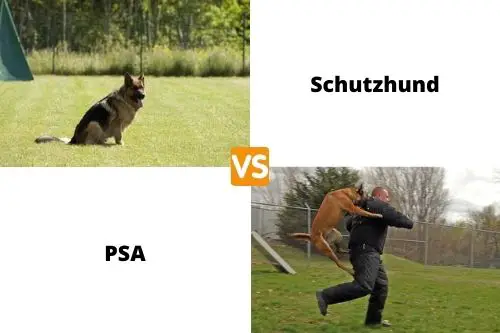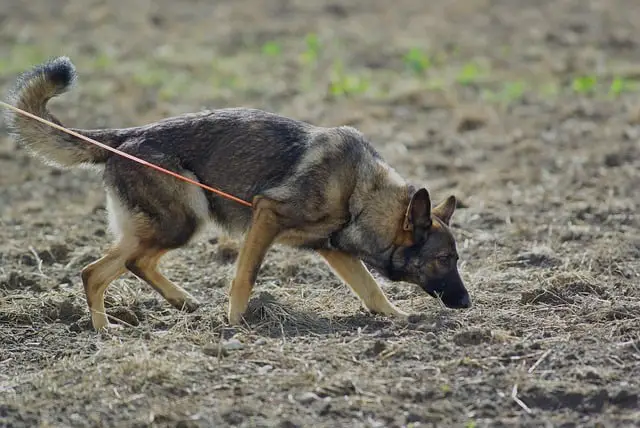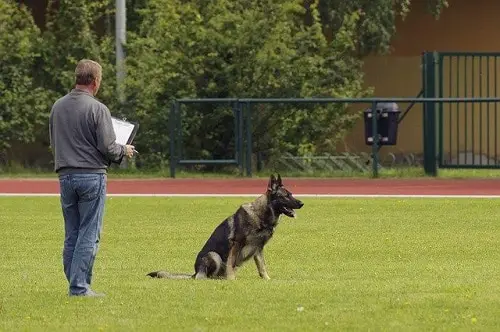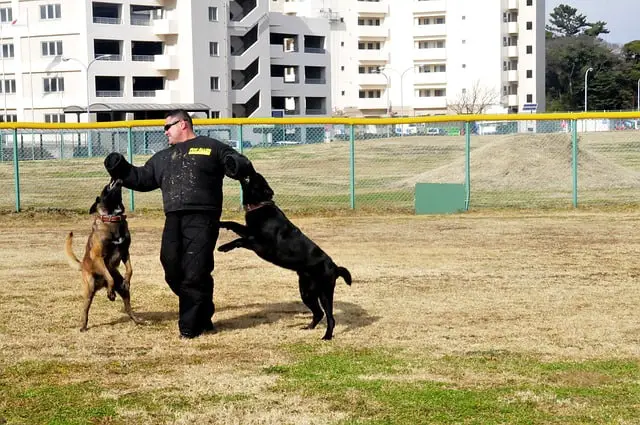When it comes to dog sports related to protection, you have many options. Schutzhund and PSA are two of the most popular ones, but you might wonder what the difference is. Although Schutzhund means “Protection dog” in German and PSA stands for Protection Sports Association, they are very different dog sports overall.
What Is The Difference Between Schutzhund (IPO/IGP) and PSA?
Unlike PSA, Schutzhund involves a tracking phase. Then, in PSA, bite work is done on a suit instead of an arm sleeve. Another big difference is that the exercises vary from trial to trial in PSA, so it’s more challenging. Besides that, protection skills developed in Schutzhund are less applicable in real-life.

Before diving into more details about the differences between those two dog sports, you should understand what each one of them is. So let’s define what Schutzhund and PSA are before comparing them together.
What Is Schutzhund Dog Training?
Schutzhund was developed to test German Shepherds for police and military work. Then, it quickly became a sport where you can train any dog in three phases: Tracking, Obedience, and Protection. Schutzhund is also competitively known as IGP, previously IPO.
In tracking, the dog has to follow a track laid by its handler or a stranger (depending on the level) and locate articles left behind by the person. For obedience, the dog has to perform multiple exercises. It includes heeling on and off-leash, basic commands (Sit, Down, and Recall), retrieving a dumbbell and jumping over a hurdle.
The last phase of Schutzhund is protection. In this part of the test, the dog has to do a blind search, hold and bark, guard, prevent the helper from escaping, defend itself, transport the helper, and protect the handler. So every exercise is very specific and predictable.
For more information about the rules and exercises, you can go on this page of the United Schutzhund Clubs of America website or read their Trial Rulebook.
Learn more about Schutzhund training!
What Is The Dog Sport Of PSA?
As I already say, PSA stands for Protection Sports Association. It’s a more recent sport developed to “provide an outlet for civilian competition in canine obedience and controlled protection.” This is a part of their mission retrieved from the home page of the PSA K9 website.
The sport of PSA has two parts: Obedience and Protection. During the obedience phase, there is at least one person with a bite suit on (decoy) that can do and toss things to distract the dog. The higher you go in titles (PSA 1, 2, and 3), the more distractions and harder it gets.
In the last level of this dog sport, the handler doesn’t know the obedience pattern, and many decoys are running around the training field. The dog must perform exercises such as heeling, basic commands (Sit, Down, and Recall), retrieving multiple objects, overcoming various obstacles, and food refusal.
On the protection side of things, PSA includes a car-jacking simulation, an attack on the handler, courage tests, and other possible surprise scenarios. There can also be a hidden bite sleeve under the suit for all levels. So protection exercises in this dog sport are realistic and change from one trial to another.
For more information on the PSA organization and the sport, you can go on this page of their website or read their Rulebook.
IPO/IGP VS PSA | The Differences
Now that you have a better understanding of what those two dog sports are, it’s time to put them side by side. Although Schutzhund and PSA involve obedience training and protection work and have many other points in common, they are still very different. Here’s why!
Phases/Tests.
The first difference regards the number and types of disciplines involved in each sport. Schutzhund has three phases, while PSA only has two parts. They both include exercises for obedience and protection, but IPO/IGP also tests the dog on his tracking skills.

Even if both sports share two types of work, it doesn’t mean they do it in the same way. So let’s compare the phases they have in common to see if there’s any difference.
Obedience.
The obedience exercises in Schutzhund and PSA are very similar. Both sports include heeling, stay/sit in motion, downs, recalls, obstacles, and retrievals. The obedience pattern and exercises will vary from one level to another in both sports.
However, there are more distractions in PSA. The dog also has to retrieve various items and go through different obstacles. Finally, the routine might change from one trial to another. Another unique thing about this canine sport is the people in suits (decoys) that distract the dog during the obedience phase.
On the other hand, IPO/IGP obedience tests have more specific exercises and routines with little to no distractions. For example, the object the dog has to retrieve must be a dumbbell. Then, the obedience pattern of a certain Schutzhund level is always the same for every trial.
Protection.
The protection phase of both sports is even more contrasting. One huge difference is the equipment used by the helper/decoy. In PSA, decoys wear a bite suit. So the dog has more places to grip on when biting. On the other hand, Schutzhund helpers only use an arm sleeve.
Besides that, protection exercises and tests are also different. In IPO/IGP, they all have has a specific order and way to do it. The dog has to search for the helper behind blinds, hold and bark, guard, prevent an escape, defend itself, protect the handler, and perform a transport.
When it comes to PSA, the scenarios are based more on real-life situations, and some of them are randomly picked by the judge. It might include a car-jacking simulation, an attack on the handler, courage tests, transports, area searching, a muzzle attack, and many other possible exercises. Thus, the protection phases in those dog sports differ a lot from one another.
Variation.
In Schutzhund, the routine and exercises are always the same. The only variation possible is when you change level. On the other hand, PSA patterns and scenarios will vary from one trial to another.
Difficulty.
IPO/IGP titles are much easier to get. The variation in PSA makes preparation harder, and extra distractions increase the difficulty even more. Schutzhund is generally less challenging because the tests are always the same and easier to pass.
Organization.
The rules and structure of the sports are also different. PSA is more recent and allows more freedom to the decoys and judges. So the regulations are not as strict as in Schutzhund.
On the other hand, IPO/IGP is more structured. The rules are less vague, the exercises are more precise, and the environment is more controlled.
Skills Developed.
Since PSA and Schutzhund are different, they don’t require the same preparation and training. The dog will develop strong bite, obedience, confidence, and other protection skills in both sports.
However, PSA is more applicable in real-life and gets closer to personal protection. On the other hand, the skills developed in IPO/IGP are more aimed toward working dogs and aren’t very useful outside of the training field.
Drive.
In Schutzhund, any drive (play, food, prey, etc.) that you can channel into the sport is good. Since biting on an arm sleeve can be perceived as a game more than an act of protection, the dog only needs the right temperament and traits for this type of work.
When it comes to PSA, the dog must have appropriate nerves. The decoys are more vocal, and there are more physical contacts. So the dog will experience more stress. Besides that, it allows more aggression when biting and attacking the decoys.
As for personal protection, the dog also needs to understand when he or his owner is in danger. That’s why a more aggressive, defensive, and protective drive might be more appropriate for the sport of PSA.
Goal.
One reason why the process isn’t the same is that the result desired is different. Trainers will do Schutzhund for breeding purposes, improving their working dog’s skills, or plain fun. In PSA, the goal is to provide an outlet and set new standards for canine obedience and protection sports.

Competition.
The competition side of things also differs from one another. In IPO/IGP, all dogs compete against each other to see who’s the best since every trial is the same.
In PSA, you can’t compare performances because the routine and exercises change from one competition to another. So the dogs compete against the sport.
Titles.
In Schutzhund, the judge notes the dogs according to a standard, and the points distribution is all planned. On the other hand, the scoring system in PSA is less strict, and each title has a different value because of the variation in the sport. Also, a dog must pass twice to get the PSA 1 title.
List Of The Main Differences Between Schutzhund And PSA!
- Schutzhund involves tracking, not PSA.
- PSA has more distractions in the obedience phase.
- In IPO/IGP, the dog bite in an arm sleeve only compared to a suit in PSA.
- The pattern and exercises vary in PSA, while it’s always the same in Schutzhund.
- In IPO/IGP, the dog must retrieve a dumbbell, but in PSA, it can be different items.
- PSA titles are generally much harder to get, and their value isn’t the same.
- Schutzhund is more structured, and rules are more strict.
- Decoys in PSA are more vocal and have more physical contact with the dog.
Which Protection Dog Sport Should You Choose?
It will depend on your goals, preferences, and your dog’s conditions. Both Schutzhund and PSA have benefits and drawbacks. IPO/IGP is more competitive, titles are created equal, and it’s easier for beginners. On the other hand, PSA is better for the dog to develop more control, focus, and real-life protection skills.
Can You Do Both Schutzhund And PSA?
You can do both IPO/IGP and PSA as long as you have the right dog, handling skills, and put in enough time. Schutzhund and PSA are very different sports, but they also have many points in common. So training a dog for both is possible. It will just require a lot of work and commitment.
Last Thoughts About IPO/IGP VS PSA!
Finally, Schutzhund and PSA differ in many ways. Although they both involve protection, obedience, and bite work, each sport has a unique angle on it. IPO/IGP is more structured and standardized. It also adds tracking into the mix. PSA is more recent, challenging, and applicable in everyday life.

So now it’s time to choose which protection sport is best for you and your dog. Whatever decision you make, I’m sure you will have fun working together. The next step is to find a PSA or Schutzhund club and a mentor, learn about the sport of your choice, and start training your dog for it.
Let’s Get That First Title!